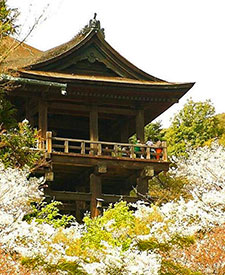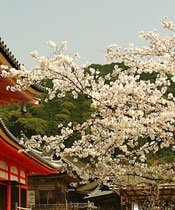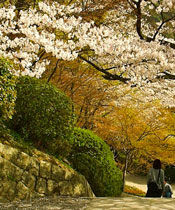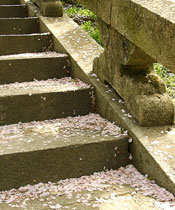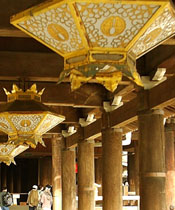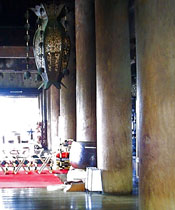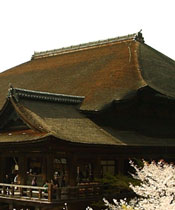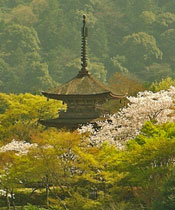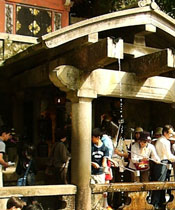The cherry blossom is Japan's most beloved and celebrated flower. Sakura motifs can be found on everything, from fans and kimono to sake cups and sword fittings, adorning almost all of the arts and crafts of Japan.
At the start of April, the landscape of Kyoto is decorated with wisps of light pink and white, drawing visitors from across Japan and abroad to take part in that most sentimental of all Japanese traditions - cherry blossom viewing, or hanami. What better place to view this revered flower than at Kyoto's most famous landmark and spiritual center - Kiyomizu Temple.
Cherry Blossom Season

at Kiyomizu Temple

Kiyomizu Temple (Kiyomizu-dera) is located in Kyoto's eastern quarter at the foot of Mt. Otowa, whose name in Japanese means, "Sound-of-Feathers Mountain." The ascent to the temple is a steep and winding walk up Kiyomizu-zaka - a charming, narrow street lined with restaurants, souvenir shops, tea rooms, and art dealers.
The sights and sounds of this area below the temple haven't changed for centuries, with many of the family-owned shops here dealing in traditional Kyoto-made arts and crafts since the Edo era. Visitors can expect to find a dazzling selection of silk fans, incense, dolls, hanging screens, antiques, and Kiyomizu-yaki porcelain - not to mention, unique treats like green tea-flavored ice cream and daikon pickles.

Unlike some of the other touristy areas in Japan that peddle stereotyped images of "Old Japan", the experience here along Kiyomizu-zaka is grounded in tradition and very, very real. Since its founding in 794 AD, Kyoto has developed as the center of both culture and commerce, and there are few places in Japan where traditional industries like textiles, lacquerware, and basket weaving are still prospering to this day. The level of craftsmanship you find in even the smallest of wares shows that the artisan spirit is still alive and thriving in Kyoto.
The temple is comprised of a number of towers, gates, and halls; thirty-three structures in total and each with its own historical and spiritual significance. Its name comes from the clear, pure waterfall which originates from a source deep within Mt. Otowa.
According to historical records, Kiyomizu Temple was established in 778 AD by the priest Enchin, who was told in a vision to "look for the clear water origin of the upper reaches of the Yodo river." After a long search, Enchin found a waterfall deep within a misty forest at the base of Mt. Otowa, and there he enshrined a wooden image of Buddha (called Kannon Bosatsu), thus marking the beginning of the temple.

During the past 1,237 years of its history, Kiyomizu Temple has been repeatedly burned and destroyed but always rebuilt to its original form. Most of the present temple structures were reconstructed between 1631 and 1633 (early Edo era) by order of Shogun Iemitsu Tokugawa. The Main Hall, or Hondo, is designated as a National Treasure and 15 other structures designated as Important Cultural Properties by the Japanese Government. In 1994, the temple was inscribed on the World Cultural Heritage List by UNESCO.
One interesting aspect of Kiyomizu-dera is the richness in the style and architecture of each building. The earlier halls are simple, austere structures with roofs made of cypress tree bark. The newer ones are painted in crimson and covered with ornate ceramic tiles, reflecting the architectural revival of the early Edo period.

But the most famous structure in the temple and principal place of worship is the Main Hall, where the Kannon Bosatsu, having survived numerous fires since the time of Enchin, is enshrined in the innermost sanctuary. Though the image is put on display only once every 30 years, visitors can peer inside the outer sanctuary. Here, the massive pillars which support the weight of the roof can be seen; each pillar is formed from a single zelkova tree (rarely found today), serving as testament to the architectural wonder of the temple.

Facing the outer sanctuary is the Butai, or "dancing stage", which extends 10 meters (33 feet) over a cliff and is supported by wooden scaffolding extending 12 meters (40 feet) down into Kin-un-Kyo gorge.
From here, perched just above the tops of the trees which fill the gorge below, Kiyomizu Temple appears to float serenely on a vast cloud of cherry blossoms - a breathtaking view that attracts an estimated 2 million visitors every year.
Over the centuries, though, several performers are said to have fallen to their deaths while acting on the Butai, and it is here where the expression, "Kiyomizu no butai kara tobiorita tsumori de" was coined, meaning literally "as if jumping off Kiyomizu stage." Today, the term is used to describe the act of summoning all of one's courage before plunging into the unknown.
While enjoying the view from the Butai, visitors are sure to notice the top stage of Koyasu-no-to - a tower nestled in the trees on the opposite side of the gorge. It is said that after praying before this tower, an imperial consort gave birth to a daughter who would later become Empress Koken (718-758). Today, expecting mothers come to the pagoda to pray for an easy child birth.

Adjacent to the Butai is Oku-no-in, or "The Innermost Temple." From here, visitors can view the Main Hall in its entirety and enjoy watching the sunset over downtown Kyoto. During cherry blossom season and momiji (maple leaf) season, the trees below the Main Hall are illuminated at night - a spectacular scene that draws the greatest number of viewers in spring and autumn.
One of the last points of interest to see before leaving the temple is the famous waterfall from which Kiyomizu-dera takes its name. Otowa-no-taki (Sound of Feather's Waterfall) is counted among the ten most famous pure water sites in Japan, and drinking from this sacred fall is said to bring one health and good fortune.
At the end of your visit, the way out is the same as the way in, and you are back to the bustling crowds and cheerful calls of the vendors along Kiyomizu-zaka. That is, unless you are fortunate enough to have found the side entrance leading down to Chawan-zaka - one of the best streets for ceramic shopping in Kyoto.
Needless to say, any visit to this historic city would be incomplete without a shopping trip along Kiyomizu-zaka and a visit to the temple above. Health, good fortune, and the finest gifts in Kyoto. What better souvenirs to take home than that?

For Visitors
During cherry blossom season, Kiyomizu Temple opens at 6:00 AM and closes at 5:30 PM. The entrance fee for adults is ¥300 and ¥200 for students.
From March 28th to April 12th, the temple is open at night and the cherry blossoms are illuminated in the gorge below the temple. The entrance fee for this nighttime event is ¥400 for adults and ¥200 for students.
Links
Kiyomizu Temple's Official Website
Kiyomizu Temple on Wikipedia
Google Map

